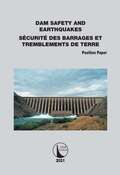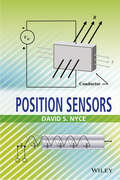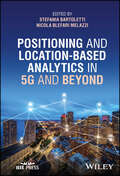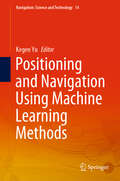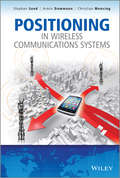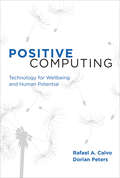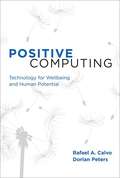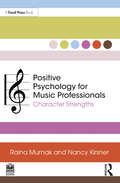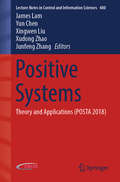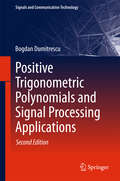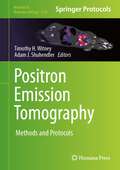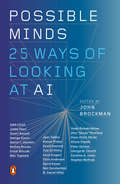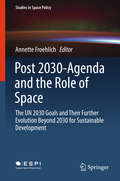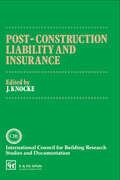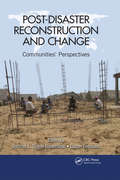- Table View
- List View
Position and Nearshore Mooring: Class Theory and Practice (Springer Series on Naval Architecture, Marine Engineering, Shipbuilding and Shipping #23)
by Alexander Arnfinn OlsenThis book provides a summary of the Class Rules and Guides for mooring systems so that they are easier to navigate and therefore implement. Mooring systems have been evolving in design, analysis, operating management, and other areas to meet the challenges of safety and efficiency. To ensure these challenges are met, Class Rules and Guides are developed and updated to keep pace with the maritime industry. This has resulted in a complex library of Class Rules and Guides. Many requirements are repeated throughout these Class Rules and Guides making use and maintenance of Class Rules/Guides increasingly cumbersome and bureaucratic. In addition to the consolidation of the current requirements, this book also includes guidance in the following areas based on the latest industry knowledge and experiences: Vortex-Induced Motion (VIM) effect. Bending-tension fatigue of mooring chains. Fiber rope mooring criteria. Mooring systems in squalls. Dynamically installed anchors. Anchor holding capacity. Mooring analysis methodology. Thruster-assisted mooring.
Position Paper Dam Safety and Earthquakes (ICOLD Bulletins Series)
by Nathalie SchaunerEarthquakes have always been a significant aspect of the design and safety of dams. This position paper deals with the seismic safety of large dams, based on experiences with large earthquakes in Japan (Tohoku earthquake, 2011, Richter magnitude 9.0), in China (Wenchuan earthquake, 2008, Richter magnitude 8.0) and in Chile (Maule earthquake, 2010, Richter magnitude 8.8). It presents ways to prevent key aspects of large dam failure under severe seismic conditions with a focus on design instead of on earthquake prediction. This is done by considering the prevention of uncontrolled rapid release of water of a storage dam under full reservoir conditions in relation to expected seismic conditions. This position paper is composed by the Committee on Seismic Aspects of Dam Design of The International Committee of Large Dams. Les tremblements de terre ont toujours été un aspect important de la conception et de la sécurité des barrages. Ce document de synthèse traite de la sécurité sismique des grands barrages, en se fondant sur l’expérience acquise lors de grands séismes au Japon (séisme de Tohoku, 2011, magnitude 9,0 sur l’échelle de Richter), en Chine (séisme de Wenchuan, 2008, magnitude 8,0 sur l’échelle de Richter) et au Chili (séisme de Maule, 2010, magnitude 8,8 sur l’échelle de Richter). Il présente des moyens de prévenir les aspects clés de la défaillance des grands barrages dans des conditions sismiques sévères en mettant l’accent sur la conception plutôt que sur la prévision des séismes. Pour ce faire, on examine la prévention d’une libération rapide et incontrôlée de l’eau d’un barrage de stockage dans des conditions de réservoir plein par rapport aux conditions sismiques prévues. Cet argumentaire est composé par le Comité sur les Aspects Sismiques des Projets de Barrages de la Commission Internationale des Grands Barrages.
Position Sensorless Control Techniques for Permanent Magnet Synchronous Machine Drives
by Gaolin Wang Guoqiang Zhang Dianguo XuThe book focuses on position sensorless control for PMSM drives, addressing both basic principles and experimental evaluation. It provides an in-depth study on a number of major topics, such as model-based sensorless control, saliency-based sensorless control, position estimation error ripple elimination and acoustic noise reduction. Offering a comprehensive and systematic overview of position sensorless control and practical issues it is particularly suitable for readers interested in the sensorless control techniques for PMSM drives. The book is also a valuable resource for researchers, engineers, and graduate students in fields of ac motor drives and sensorless control.
Position Sensors
by David S. NyceA resource on position sensor technology, including background, operational theory, design and applications This book explains the theory and applications of the technologies used in the measurement of linear and angular/rotary position sensors. The first three chapters provide readers with the necessary background information on sensors. These chapters review: the working definitions and conventions used in sensing technology; the specifications of linear position transducers and sensors and how they affect performance; and sensor output types and communication protocols. The remaining chapters discuss each separate sensor technology in detail. These include resistive sensors, cable extension transducers, capacitive sensors, inductive sensors, LVDT and RVDT sensors, distributed impedance sensors, Hall Effect sensors, magnetoresistive sensors, magnetostrictive sensors, linear and rotary encoders, and optical triangulation position sensors. Discusses sensor specification, theory of operation, sensor design, and application criteria Reviews the background history of the linear and angular/rotary position sensors as well as the underlying engineering techniques Includes end-of-chapter exercises Position Sensors is written for electrical, mechanical, and material engineers as well as engineering students who are interested in understanding sensor technologies.
Positioning and Location-based Analytics in 5G and Beyond
by Stefania Bartoletti; Nicola Blefari MelazziPOSITIONING AND LOCATION-BASED ANALYTICS IN 5G AND BEYOND Understand the future of cellular positioning with this introduction The fifth generation (5G) of mobile network technology are revolutionizing numerous aspects of cellular communication. Location information promises to make possible a range of new location-dependent services for end users and providers alike. With the new possibilities of this location technology comes a new demand for location-based analytics, a new paradigm for generating and analyzing dynamic location data for a wide variety of purposes. Positioning and Location-based Analytics in 5G and Beyond introduces the foundational concepts related to network localization, user positioning, and location-based analytics in the context of cutting-edge mobile networks. It includes information on current location-based technologies and their application, and guidance on the future development of location systems beyond 5G. The result is an accessible but rigorous guide to a bold new frontier in cellular technology. Positioning and Location-based Analytics in 5G and Beyond readers will also find: Contributions from leading researchers and industry professionals High-level insights into 5G and its future evolution In-depth coverage of subjects such as positioning enablers, location-aware network management, reference standard architectures, and more Positioning and Location-based Analytics in 5G and Beyond is ideal for researchers and industry professionals with an understanding of network communications and a desire to understand the future of the field.
Positioning and Navigation Using Machine Learning Methods (Navigation: Science and Technology #14)
by Kegen YuThis is the first book completely dedicated to positioning and navigation using machine learning methods. It deals with ground, aerial, and space positioning and navigation for pedestrians, vehicles, UAVs, and LEO satellites. Most of the major machine learning methods are utilized, including supervised learning, unsupervised learning, deep learning, and reinforcement learning. The book presents both fundamentals and in-depth studies as well as practical examples in positioning and navigation. Extensive data processing and experimental results are provided in the major chapters through conducting experimental campaigns or using in-situ measurements.
Positioning in Wireless Communications Systems
by Stephan Sand Christian Mensing Armin DammannPositioning in Wireless Communications Systems explains the principal differences and similarities of wireless communications systems and navigation systems. It discusses scenarios which are critical for dedicated navigation systems such as the Global Positioning System (GPS) and which motivate the use of positioning based on terrestrial wireless communication systems.The book introduces approaches for determination of parameters which are dependent on the position of the mobile terminal and also discusses iterative algorithms to estimate and track the position of the mobile terminal. Models for radio propagation and user mobility are important for performance investigations and assessments using computer simulations. Thus, channel and mobility models are explored, especially focussing on critical navigation environments like urban or indoor scenarios.Positioning in Wireless Communications Systems examines advanced algorithms such as hybrid data fusion of satellite navigation and positioning with wireless communications and cooperative positioning among mobile terminals.. The performance of the discussed positioning techniques are explored on the basis of already existing and operable terrestrial wireless communication systems such as GSM, UMTS, or LTE and it is shown how positioning issues are fixed in respective standards.Written by industry experts working at the cutting edge of technological development, the authors are well placed to give an excellent view on this topic, enabling in-depth coverage of current developments.Key features* Unique in its approach to dealing with a heterogeneous system approach, different cell structures and signal proposals for future communications systems* Covers hybrid positioning investigating how GNSS and wireless communications positioning complement each other* Applications and exploitation of positioning information are discussed to show the benefits of including this information in several parts of a wireless communications system
Positive Computing: Technology for Wellbeing and Human Potential
by Rafael A. Calvo Dorian PetersA case for building a digital environment that can make us happier and healthier, not just more productive, and a theoretical framework for doing so.On the eve of Google's IPO in 2004, Larry Page and Sergey Brin vowed not to be evil. Today, a growing number of technologists would go further, trying to ensure that their work actively improves people's lives. Technology, so pervasive and ubiquitous, has the capacity to increase stress and suffering; but it also has the less-heralded potential to improve the well-being of individuals, society, and the planet. In this book, Rafael Calvo and Dorian Peters investigate what they term “positive computing”—the design and development of technology to support psychological well-being and human potential. Calvo and Peters explain that technologists' growing interest in social good is part of a larger public concern about how our digital experience affects our emotions and our quality of life—which itself reflects an emerging focus on humanistic values in many different disciplines. Synthesizing theory, knowledge, and empirical methodologies from a variety of fields, they offer a rigorous and coherent foundational framework for positive computing. Sidebars by experts from psychology, neuroscience, human–computer interaction, and other disciplines supply essential context. Calvo and Peters examine specific well-being factors, including positive emotions, self-awareness, mindfulness, empathy, and compassion, and explore how technology can support these factors. Finally, they offer suggestions for future research and funding.SidebarsTimothy N. Bickmore, Jeremy Bailenson, danah boyd, Jane Burns, David R. Caruso, Mihaly Csikszentmihalyi, Felicia Huppert, Mary-Helen Immordino-Yang, Adele Krusche and J. Mark G. Williams, Jane McGonigal, Jonathan Nicholas, Don Norman, Yvonne Rogers
Positive Computing
by Dorian Peters Rafael A. CalvoOn the eve of Google's IPO in 2004, Larry Page and Sergey Brin vowed not to be evil. Today, a growing number of technologists would go further, trying to ensure that their work actively improves people's lives. Technology, so pervasive and ubiquitous, has the capacity to increase stress and suffering; but it also has the less-heralded potential to improve the well-being of individuals, society, and the planet. In this book, Rafael Calvo and Dorian Peters investigate what they term "positive computing" -- the design and development of technology to support psychological well-being and human potential. Calvo and Peters explain that technologists' growing interest in social good is part of a larger public concern about how our digital experience affects our emotions and our quality of life -- which itself reflects an emerging focus on humanistic values in many different disciplines. Synthesizing theory, knowledge, and empirical methodologies from a variety of fields, they offer a rigorous and coherent foundational framework for positive computing. Sidebars by experts from psychology, neuroscience, human--computer interaction, and other disciplines supply essential context. Calvo and Peters examine specific well-being factors, including positive emotions, self-awareness, mindfulness, empathy, and compassion, and explore how technology can support these factors. Finally, they offer suggestions for future research and funding.SidebarsTimothy N. Bickmore, Jeremy Bailenson, danah boyd, Jane Burns, David R. Caruso, Mihaly Csikszentmihalyi, Felicia Huppert, Mary-Helen Immordino-Yang, Adele Krusche and J. Mark G. Williams, Jane McGonigal, Jonathan Nicholas, Don Norman, Yvonne Rogers
Positive Energy Buildings: Concepts, Challenges and Opportunities (Green Energy and Technology)
by Rita Lavikka Hassam Ur Rehman Francesco Reda Abdul Samad KaziThis book investigates positive energy buildings (PEBs). It provides and describes them, explains why they are important in the fight against climate change and discusses how they might be implemented. This book begins by contextualizing PEBs, discussing concepts, definitions and how they may be included by planning authorities in development plans. It then thoroughly explains what PEBs are and their impact on a climate-neutral economy. The book discusses technological, economic, societal and regulatory challenges and opportunities in employing PEBs, before concluding with possible scenarios for implementing them. This book is of use to researchers, practitioners, and policy makers interested in local and decentralized energy, as well as plans to achieve carbon neutrality.
Positive Psychology for Music Professionals: Character Strengths
by Raina Murnak Nancy KirsnerPositive Psychology for Music Professionals is a guidebook to the building blocks of positive psychology and character strengths, and the ways in which they can be used by music professionals throughout the industry to empower, celebrate, and leverage individuality. Written in a highly accessible and entertaining tone – and based on the science of character pioneered by the VIA Institute – this book is designed to introduce the language, themes, and concepts of a strength-based approach to working in the music industry. Targeted exercises, self-reflections, interviews, and profession-specific case studies encourage readers to harness the power of their strengths to shift to an open mindset, create more positive working relationships, and improve institutions within their field. Positive Psychology for Music Professionals is essential reading for music professionals of all kinds, including aspiring and established musicians, students, music producers, educators, and managers in all sectors of the industry.
The Positive Side of Occupational Health Psychology
by Marit Christensen Per Øystein Saksvik Maria Karanika-MurrayThis book serves as an introduction to the Nordic approach to Occupational Health Psychology and illustrates how this perspective can be transferred to a global audience. It discusses a joining of attitudes from Positive Psychology accompanied by experiences drawn from the Nordic work/life context. Over the decades, Nordic countries have gathered a great deal of experience on the meaningfulness of work, work engagement, presenteeism, absenteeism, job crafting, work family balance, intervention and reorganization. These experiences are explained and offered as a different approach to Occupational Health Psychology, while avoiding the more traditional detrimental topics such as stress, conflict burnout and poor well-being. Instead the authors discuss subjects such as engagement, healthy change, prosperity and welfare and are applied to the current ideas on Occupational Health Science. This book shows that using interdisciplinary observations can help our understanding of modern worker health. It offers gives readers an opportunity to consider how a combination of good work and good health can be stimulated in theory and in practice.
Positive Systems: Theory and Applications (POSTA 2018) (Lecture Notes in Control and Information Sciences #480)
by James Lam Yun Chen Xingwen Liu Xudong Zhao Junfeng ZhangThis book presents high-quality original contributions on positive systems, including those with positivity in compartmental switched systems, Markovian jump systems, Boolean networks, interval observer design, fault detection, and delay systems. It comprises a selection of the best papers from POSTA 2018, the 6th International Conference on Positive Systems, which was held in Hangzhou, China, in August 2018. The POSTA conference series represents a targeted response to the growing need for research that reports on and critically discusses a wide range of topics concerning the theory and applications of positive systems. The book offers valuable insights for researchers in applied mathematics, control theory and their applications.
Positive Trigonometric Polynomials and Signal Processing Applications
by Bogdan DumitrescuPositive Trigonometric Polynomials and Signal Processing Applications has two parts: theory and applications. The theory of sum-of-squares trigonometric polynomials is presented unitarily based on the concept of Gram matrix (extended to Gram pair or Gram set). The presentation starts by giving the main results for univariate polynomials, which are later extended and generalized for multivariate polynomials. The applications part is organized as a collection of related problems that use systematically the theoretical results. All the problems are brought to a semidefinite programming form, ready to be solved with algorithms freely available, like those from the library SeDuMi.
Positron Emission Tomography: Methods and Protocols (Methods in Molecular Biology #2729)
by Timothy H. Witney Adam J. ShuhendlerThis detailed volume explores key concepts and experimental design related to Positron Emission Tomography (PET) imaging that have revolutionized our understanding of human biology. The first part focuses on recent advances in radiotracer probe development to enable the detection of materials, from large macromolecules to complicated drug-like structures. The next section describes how key physiological and pathophysiological processes can be interrogated and quantifiably measured with this imaging technique. Finally, chapters examine important technological developments in the field that are revolutionizing the way these innovative PET probes are utilized in the clinic. Written for the highly successful Methods in Molecular Biology series, chapters include introductions to their respective topics, lists of the necessary materials and reagents, step-by-step and readily reproducible laboratory protocols, as well as tips on troubleshooting and avoiding known pitfalls. Authoritative and practical, Positron Emission Tomography: Methods and Protocols serves as an ideal guide for researchers looking to use imaging to revolutionize the way we diagnose and treat disease.
Positron Profilometry: Probing Material Depths for Enhanced Understanding (SpringerBriefs in Materials)
by Jerzy DryzekThis book provides a comprehensive overview of positron profilometry, specifically focusing on the analysis of defect depth distribution in materials. Positron profilometry plays a crucial role in understanding and characterizing defects in a wide range of materials, including metals, semiconductors, polymers, and ceramics. By analyzing the depth distribution of defects, researchers can gain insights into various material properties, such as crystal structure, defect density, and diffusion behavior. The author's extensive research spanning a period of two decades has primarily centered on subsurface zones. These regions, located beneath the surface and subjected to various surface processes, play a crucial role in generating defect distributions. Three experimental techniques and their data analysis are described in detail: a variable-energy positron beam (VEP) called sometimes a slow positron beam, a technique called implantation profile depth scanning (DSIP), and a sequential etching (SET) technique. The usability of these techniques is illustrated by many examples of measurements by the author and others.
Possession
by Peter JamesA terrifying novel of a young man who is willing to defy everything. Even death...Fabian Hightower has been killed in a car crash. At least, that is what a policeman is asking Alex, his mother to believe. But Alex knows she saw him that morning - at a time when he must have been dead. When the funeral is over Alex tries hard to forget her bizarre experience. But her mind seems to be playing strange tricks on her, turning her grief into horror. When she turns to a medium her worst fears are realised. Fabian has unfinished business and he is determined to come back. But why? Whatever the answer, something terrifies the medium so much she refuses to return. Alex longs to turn to others for support. But there is a secret about Fabian that only she knows - a secret she must never share...'One of the best crime writers in the business.' Karin Slaughter'Genuinely frightening ... only Mary Shelley's Frankenstein and Stephen King's The Shining have scared me as much.' Evening StandardRead more from the multi-million copy bestselling author of the Roy Grace novels:Possession DreamerSweet Heart Twilight Prophecy Host Alchemist Denial The Truth Faith * Each Peter James novel can be read as a standalone*
Possession
by Peter JamesA terrifying novel of a young man who is willing to defy everything. Even death...Fabian Hightower has been killed in a car crash. At least, that is what a policeman is asking Alex, his mother to believe. But Alex knows she saw him that morning - at a time when he must have been dead. When the funeral is over Alex tries hard to forget her bizarre experience. But her mind seems to be playing strange tricks on her, turning her grief into horror. When she turns to a medium her worst fears are realised. Fabian has unfinished business and he is determined to come back. But why? Whatever the answer, something terrifies the medium so much she refuses to return. Alex longs to turn to others for support. But there is a secret about Fabian that only she knows - a secret she must never share...'One of the best crime writers in the business.' Karin Slaughter'Genuinely frightening ... only Mary Shelley's Frankenstein and Stephen King's The Shining have scared me as much.' Evening StandardRead more from the multi-million copy bestselling author of the Roy Grace novels:Possession DreamerSweet Heart Twilight Prophecy Host Alchemist Denial The Truth Faith * Each Peter James novel can be read as a standalone*
Possibility Theory for the Design of Information Fusion Systems (Information Fusion and Data Science)
by Basel Solaiman Éloi BosséThis practical guidebook describes the basic concepts, the mathematical developments, and the engineering methodologies for exploiting possibility theory for the computer-based design of an information fusion system where the goal is decision support for industries in smart ICT (information and communications technologies). This exploitation of possibility theory improves upon probability theory, complements Dempster-Shafer theory, and fills an important gap in this era of Big Data and Internet of Things.The book discusses fundamental possibilistic concepts: distribution, necessity measure, possibility measure, joint distribution, conditioning, distances, similarity measures, possibilistic decisions, fuzzy sets, fuzzy measures and integrals, and finally, the interrelated theories of uncertainty..uncertainty. These topics form an essential tour of the mathematical tools needed for the latter chapters of the book. These chapters present applications related to decision-making and pattern recognition schemes, and finally, a concluding chapter on the use of possibility theory in the overall challenging design of an information fusion system. This book will appeal to researchers and professionals in the field of information fusion and analytics, information and knowledge processing, smart ICT, and decision support systems.
Possible Minds: Twenty-Five Ways of Looking at AI
by John BrockmanScience world luminary John Brockman assembles twenty-five of the most important scientific minds, people who have been thinking about the field artificial intelligence for most of their careers, for an unparalleled round-table examination about mind, thinking, intelligence and what it means to be human."Artificial intelligence is today's story--the story behind all other stories. It is the Second Coming and the Apocalypse at the same time: Good AI versus evil AI." --John BrockmanMore than sixty years ago, mathematician-philosopher Norbert Wiener published a book on the place of machines in society that ended with a warning: "we shall never receive the right answers to our questions unless we ask the right questions.... The hour is very late, and the choice of good and evil knocks at our door." In the wake of advances in unsupervised, self-improving machine learning, a small but influential community of thinkers is considering Wiener's words again. In Possible Minds, John Brockman gathers their disparate visions of where AI might be taking us.The fruit of the long history of Brockman's profound engagement with the most important scientific minds who have been thinking about AI--from Alison Gopnik and David Deutsch to Frank Wilczek and Stephen Wolfram--Possible Minds is an ideal introduction to the landscape of crucial issues AI presents. The collision between opposing perspectives is salutary and exhilarating; some of these figures, such as computer scientist Stuart Russell, Skype co-founder Jaan Tallinn, and physicist Max Tegmark, are deeply concerned with the threat of AI, including the existential one, while others, notably robotics entrepreneur Rodney Brooks, philosopher Daniel Dennett, and bestselling author Steven Pinker, have a very different view. Serious, searching and authoritative, Possible Minds lays out the intellectual landscape of one of the most important topics of our time.
Post 2030-Agenda and the Role of Space: The UN 2030 Goals and Their Further Evolution Beyond 2030 for Sustainable Development (Studies in Space Policy #17)
by Annette FroehlichThis book provides a deep insight to which extent further improvement should be envisaged to ensure and improve the sustainable development beyond 2030 (the Sustainable Development Goals is a set of 17 global goals with 169 associated targets which the state community adopted in 2015). As the world, its environment, economy and society is getting more and more technical advanced, it is of high interest to analyze how space and its various applications can support this development. Once the Goals of the “2030 Agenda for Sustainable Development” will be achieved new challenges are waiting. The analysis takes into account a proactive use of artificial intelligence for the development based on space infrastructure. Another important aspect revolves around the economic development which asks for further analysis of the cryptocurrencies relationship with space applications and how to use space based cryptocurrencies for development. Environment-wise the challenges for a sustainable development on Earth i.e. water supply, but also in outer space are requested ensuring a sustainable exploration and exploitation of space and its orbital resources. The book also highlights possible contributions of the post-2030 space industry to global economic development based on satellite technology and the enlargement of the scope of application of satellite data in administration and Justice to ensure development of effective, accountable and transparent institutions at all levels to promote growth, stability and security and peace on global level.
Post-Cold War Conflict Deterrence
by Naval Studies BoardDeterrence as a strategic concept evolved during the Cold War. During that period, deterrence strategy was aimed mainly at preventing aggression against the United States and its close allies by the hostile Communist power centers--the Union of Soviet Socialist Republics (USSR) and its allies, Communist China and North Korea. In particular, the strategy was devised to prevent aggression involving nuclear attack by the USSR or China. Since the end of the Cold War, the risk of war among the major powers has subsided to the lowest point in modern history. Still, the changing nature of the threats to American and allied security interests has stimulated a considerable broadening of the deterrence concept.Post-Cold War Conflict Deterrence examines the meaning of deterrence in this new environment and identifies key elements of a post-Cold War deterrence strategy and the critical issues in devising such a strategy. It further examines the significance of these findings for the U.S. Navy and Marine Corps. Quantitative and qualitative measures to support judgments about the potential success or failure of deterrence are identified. Such measures will bear on the suitability of the naval forces to meet the deterrence objectives. The capabilities of U.S. naval forces that especially bear on the deterrence objectives also are examined. Finally, the book examines the utility of models, games, and simulations as decision aids in improving the naval forces' understanding of situations in which deterrence must be used and in improving the potential success of deterrence actions.
Post-Construction Liability and Insurance
by J. KnockeWith the single European market and the growing internationalisation of the work of architects, engineers and contractors it is important for professionals to be aware of the liability provisions of legal systems around the world. An essential reference for lawyers and insurance companies, especially in construction law and insurance, this is required reading for construction professionals involved in international work.
Post-disaster Navigation and Allied Services over Opportunistic Networks (Smart Innovation, Systems and Technologies #228)
by Suman Bhattacharjee Siuli Roy Sipra Das BitThis book provides the details of developing a digital pedestrian map construction system over the intermittently connected mobile network. Over the past couple of decades, countries across the world, both developing and developed, have witnessed a significant number of disasters. Thus, it has become mandatory for each of the disaster-prone countries to equip themselves with appropriate measures to cope with the challenges of providing post-disaster services. Some of the serious challenges are incapacitated communication infrastructure, unstable power supply and inaccessible road networks. Out of these challenges, the destruction of road networks, especially in developing countries, acts as a major hindrance to effective disaster management. To be more specific, the success of a disaster response operation generally depends on the speed of evacuation and transportation of adequate amount of relief materials at the right time to the disaster-affected areas. Hence, map-based navigation support is a primary requirement for post-disaster relief operations. This book also provides the solution of the two other important post-disaster management services such as situational awareness and resource allocation. Both of these services are invariably dependent on the existence of navigation support. Finally, in order to offer such services, the other challenge is to address the problem of incapacitated communication infrastructure. This book also deals with such challenges in post-disaster scenarios and develops automated post-disaster management services.
Post-Disaster Reconstruction and Change: Communities' Perspectives
by Jennifer E. Duyne Barenstein Esther LeemannSuccessful recovery following a disaster depends upon transcending the disciplinary divides of architecture, engineering, and planning and emphasizing the importance of community perspectives in the post-disaster reconstruction process. Effective results in community recovery mandate that we holistically examine the complex interrelationship betwee

